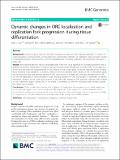Dynamic changes in ORC localization and replication fork progression during tissue differentiation
Author(s)
Kashevsky, Helena; Von Stetina, Jessica R.; Bell, George W.; Hua, Brian; Orr-Weaver, Terry
Download12864_2018_Article_4992.pdf (2.031Mb)
PUBLISHER_CC
Publisher with Creative Commons License
Creative Commons Attribution
Terms of use
Metadata
Show full item recordAbstract
Background
Genomic regions repressed for DNA replication, resulting in either delayed replication in S phase or underreplication in polyploid cells, are thought to be controlled by inhibition of replication origin activation. Studies in Drosophila polytene cells, however, raised the possibility that impeding replication fork progression also plays a major role.
Results
We exploited genomic regions underreplicated (URs) with tissue specificity in Drosophila polytene cells to analyze mechanisms of replication repression. By localizing the Origin Recognition Complex (ORC) in the genome of the larval fat body and comparing this to ORC binding in the salivary gland, we found that sites of ORC binding show extensive tissue specificity. In contrast, there are common domains nearly devoid of ORC in the salivary gland and fat body that also have reduced density of ORC binding sites in diploid cells. Strikingly, domains lacking ORC can still be replicated in some polytene tissues, showing absence of ORC and origins is insufficient to repress replication. Analysis of the width and location of the URs with respect to ORC position indicates that whether or not a genomic region lacking ORC is replicated is controlled by whether replication forks formed outside the region are inhibited.
Conclusions
These studies demonstrate that inhibition of replication fork progression can block replication across genomic regions that constitutively lack ORC. Replication fork progression can be inhibited in both tissue-specific and genome region-specific ways. Consequently, when evaluating sources of genome instability it is important to consider altered control of replication forks in response to differentiation.
Date issued
2018-08Department
Massachusetts Institute of Technology. Department of BiologyJournal
BMC Genomics
Publisher
BioMed Central
Citation
Hua, Brian L. et al. "Dynamic changes in ORC localization and replication fork progression during tissue differentiation." BMC Genomics 2018, 19 (August 2018): 623 © 2018 The Author(s)
Version: Final published version
ISSN
1471-2164